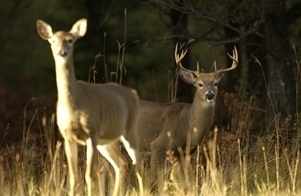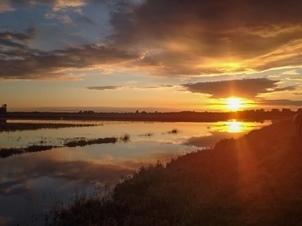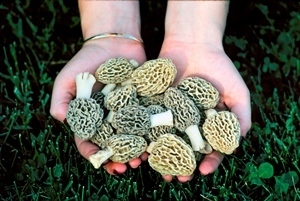 Nearly 600 people so far have attended a series of public engagement meetings on chronic wasting disease, a fatal neurological disease that has affected the deer population in a handful of Michigan counties. The final meetings will take place in Gaylord (May 1), Newberry (May 2) and Houghton (May 3).
While the face-to-face meetings have provided a great forum in which the DNR can both share information and hear feedback from hunters and other interested community members, there are online opportunities for those who’ve been unable to attend any of the meetings. A video of the DNR presentation on CWD, by DNR state wildlife veterinarian Dr. Kelly Straka and deer management specialist Chad Stewart, and an online survey are available on the DNR website michigan.gov/cwd.
All feedback is due by Friday, May 4, and will be shared with the Michigan Natural Resources Commission at its May meeting.
Chronic wasting disease is a serious wildlife challenge. The DNR hopes to receive broad, thoughtful feedback from throughout the state, feedback that will help shape next steps moving forward. For more information, contact Chad Stewart, 517-284-4745.
|
 Many things come to mind during the month of May: Mother’s Day and Cinco de Mayo, for example. But it’s also American Wetlands Month, a chance to learn more about and appreciate those areas where land and water meet.
Wetlands are part of the landscape that contain water for all or part of the year. They are characterized by the presence of water-loving plants and hydric (containing plenty of moisture) soils.
Home to 10 million acres of wetlands before European settlers arrived, Michigan still has about half of those wetlands. The Wetland Wonders – seven premier managed waterfowl hunt areas scattered across the southern Lower Peninsula – were created in the 1960s to provide exceptional waterfowl hunting opportunities, and are still managed today to provide waterfowl habitat for nesting and migration and great habitat for other wetland wildlife.
With the warmer weather on the way, the Wetland Wonders also offer accessible, scenic places perfect for a day of hiking, birding, kayaking or fishing.
This spring and summer, DNR staff will be working to enhance waterfowl habitat at these areas by planting crops like corn, millet and buckwheat for ducks and geese to eat during fall migration.
|
Staff also will be removing invasive species like European frogbit and Phragmites that outcompete native plants and aren’t attractive food sources for wildlife. This work helps ensure that the Wetland Wonders are both spectacular places to visit and beneficial to wildlife.
Interested in helping with efforts to provide habitat for Michigan’s wildlife? Hunting license fees help pay for habitat management at state game and wildlife areas. Even if you’re not a hunter in the traditional sense, consider purchasing an $11 base license to benefit the creatures you hunt with binoculars, cameras and spotting scopes.
Get out and enjoy the state’s outstanding, scenic wetlands areas! Learn more at michigan.gov/wetlandwonders or contact Holly Vaughn in the DNR Wildlife Division, 313-396-6863.
If you’d like to read more about the history and benefits of Michigan’s wetlands, check out this recent Showcasing the DNR story.
 As spring finally approaches and 2018’s seemingly never-ending winter slips into the rearview mirror, Michigan’s native frogs and toads are beginning to call and mate in ponds, lakes and flooded river beds and woodlands throughout the state. It’s a good time for the DNR to remind people about state regulations regarding the collection and possession of frogs, toads and salamanders.
In order to protect breeding colonies, these animals (including tadpoles) may only be collected and possessed by the public from the last Saturday in May through Nov. 15. Outside of this possession season, the public is encouraged to take walks and observe them in their natural habitat but not interfere with or directly handle the animals.
When the possession season opens May 26, people 17 years of age and older are required to have a 2018 recreational fishing license to collect and possess frogs, toads and salamanders. A strict possession limit of 10 animals (in any combination) is enforced. Those interested in harvesting frogs for a meal are reminded that frogs may be caught by hand, net, trap, seine or spear. However, frogs may not be speared in Michigan at night with the aid of an artificial light. Children and youth younger than 17 do not need a fishing license, but still are subject to the possession season limit as well as harvest methods described above.
“Practicing catch-and-release techniques is a great way for parents to encourage their children’s natural curiosity about frogs, toads and salamanders,” said DNR biologist Tom Goniea. “We also strongly recommend not trying to keep wild frogs, toads or salamanders as pets, because they generally will not survive well in captivity.”
Regardless, when the season closes Nov. 15, all living frogs, toads or salamanders collected and in possession from the open season must be released back into the wild.
Want to learn more? See page 22 of the 2018 Michigan Fishing Guide or contact Tom Goniea, 517-284-5830 or Elyse Walter, 517-284-5839.
|
 In case you missed it, a recent “Showcasing the DNR” story told of DNR employee Andy Evans’s adventures in seeking out morel mushrooms in Michigan’s forests. Andy works out of the DNR customer service center in Gaylord and frequently answers the public’s questions about the state’s natural resources and outdoor recreation opportunities, and fun things to do in the great outdoors.
On Andy’s morel hunt, he was armed with a compass, a jackknife, mesh bags, and – thanks to the Mi-HUNT mapping tool – a good idea of where to start his search.
Read the Showcasing story to learn more about Andy’s outing and how to plan your own search for morels.
|
 When you head “Up North” for the first time this season, make sure that removing anything that might attract bears is high on your to-do list.
Many northern Michigan homes, cottages and cabins are sprinkled across the countryside and near inland lakes – beautiful locations that also are home to more than 12,000 adult black bears. That makes it extremely important to know how to co-exist with bears.
“I know every year I need to make sure I have my bird feeder down before the bears are up and moving,” said Wexford County resident Joyce Oatley. “It’s something my husband and I are used to; it’s a trade-off to live where we do. I love bears, but I know what I need to do to be responsible.”
Bears are omnivores, meaning they eat a variety of plant and animal matter. Bears also have an excellent sense of smell, as well as the ability to remember where they’ve found meals in the past. That’s why it’s critical to remove attracting food sources before a bear finds them. There’s no better way for an animal to lose its natural fear of humans, than by receiving a food reward like bird seed or suet, pet food or garbage.
“Michigan has plenty of natural food for bears, but they won’t pass by something easy like a garbage can or a bird feeder to get an easy meal,” said DNR bear specialist Kevin Swanson. “It’s very important that we don’t train a wild animal like a bear to get comfortable being near people. We need to keep bears at a distance.”
Bear populations and their distribution are controlled through regulated hunting. The 2018 bear hunting application period runs May 1 to June 1. Be sure to apply for a hunt or a point. Learn more in this DNR bear drawing video.
For more information about living with bears or the upcoming hunting application period, contact Katie Keen, 989-385-0336.
|
|